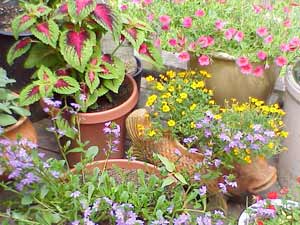
Some of the most spectacular gardens found anywhere are on the rooftops and patios of the world's largest cities.
Today's condominium owners and apartment dwellers do not have to forsake gardening. In fact, they can create their own garden hideaway in small spaces.
Gardening in small space means you plant in containers, choose plants carefully, grow up on trellises instead of out, hang plants from something overhead and, above all, be bold.
Here are some tips for small-space growing:
Containers. People grow in everything from custom-made pottery to antique bathtubs, with clay pots and wooden planters being more common. Any container that appeals to you is a possibility, but it must have drainage holes at the bottom. Cover the holes (but don't block them) with a section of window screen so the soil doesn't leak out. Set big plants on platforms with casters, so you can roll them around to redecorate or roll them indoors over the winter.
Hanging baskets. The most dramatic hanging planters are wire baskets lined with moss, filled with a growing medium and planted. These allow you to plant all over the basket surface, including the bottom, by pushing plants up through the moss into the growing medium.
Soil mix. Buy a bag of dry, soilless mix for container gardening. If you have enough storage space, buy a big bag. You need to soak the soil with water before planting. This process can be messy, so plan ahead and do it outside if possible. Moisten only as much as you'll need for the current project.
Annuals. Choose plants with long blooming periods. Look for annuals that are short instead of tall, since tall plants often need staking and that can be difficult in containers.
Bulbs. They can be "forced" to blossom in containers whenever you choose. Sometimes they are planted in large wooden or clay bowls. Set the bulbs in soilless mix almost touching each other. Sprinkle more mix between and over them until they are barely covered. Put them in a cool, dark place until growth appears, usually about 8 weeks. Set them in the sun and they will grow and blossom. Bulbs that are forced should not be planted again.
Perennials. Can be grown in containers and moved in and out of the house. Experienced container gardeners will mix bulbs, annuals and perennials for a long-blooming display. In this use, bulbs are not forced and come back year after year because they are able to store food.
Herbs, vegetables, shrubs, and citrus fruits can all be grown in containers. More and more vegetable varieties are available specifically for container growing. Check plant descriptions.
Watering. Keep an eye on your container garden. It can dry out quickly in hot weather. If you really get into it, you might want to consider a drip irrigation system. This is a network of plastic tubing that can be regulated to provide a constant moisture supply to your plants.
Fertilizing. Fertilizers wash out of container soils faster than out of garden soil. A liquid fertilizer, applied at half strength every two weeks, is one common technique. You can also try plant spikes (a solid fertilizer that slowly dissolves with watering) or mixing organics into the soil.
As perennial plants grow, they can fill the entire pot with their roots. They will become stunted if they are allowed to remain rootbound, so from time to time you can move them up to larger pots with a fresh batch of soilless mix.
For the investment, a container garden patio or deck will provide an enormous amount of pleasure.